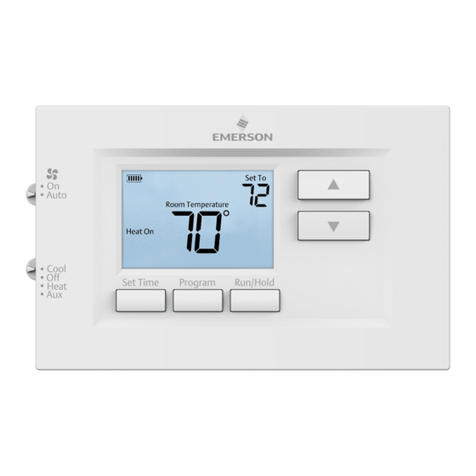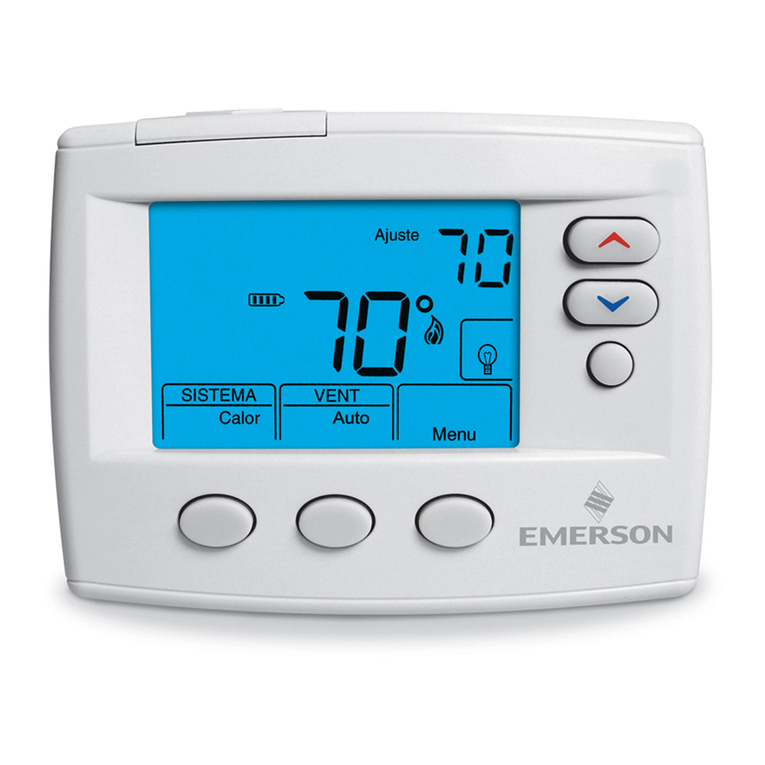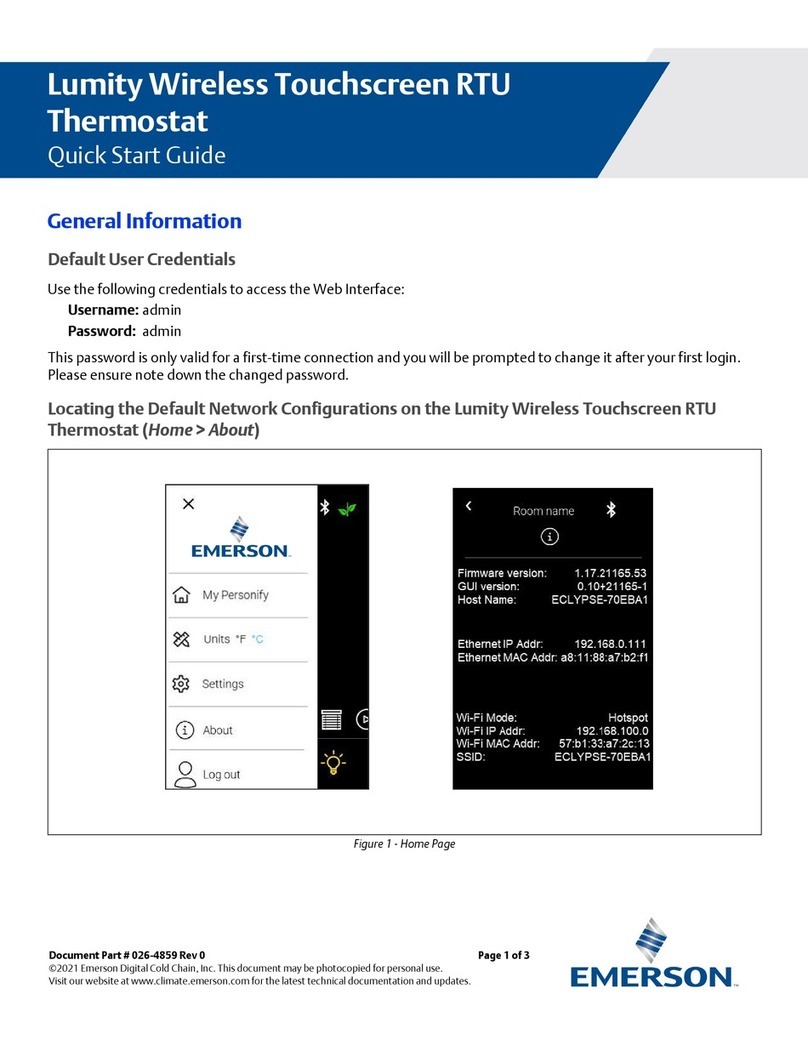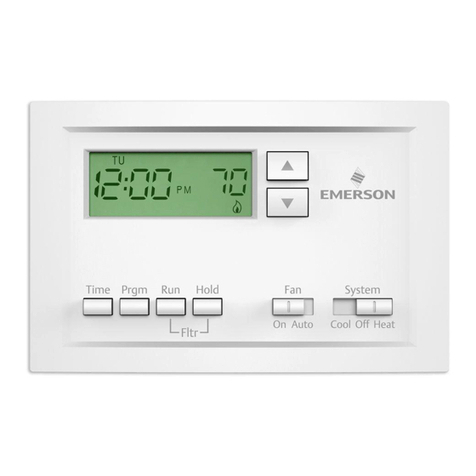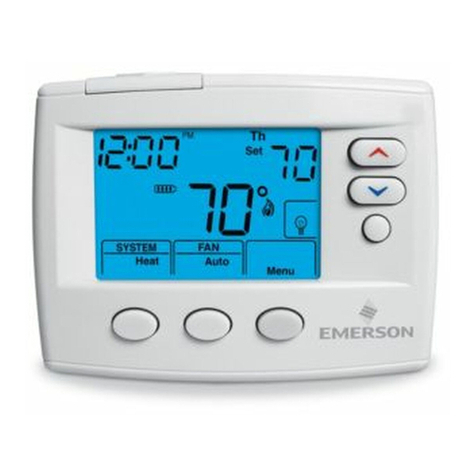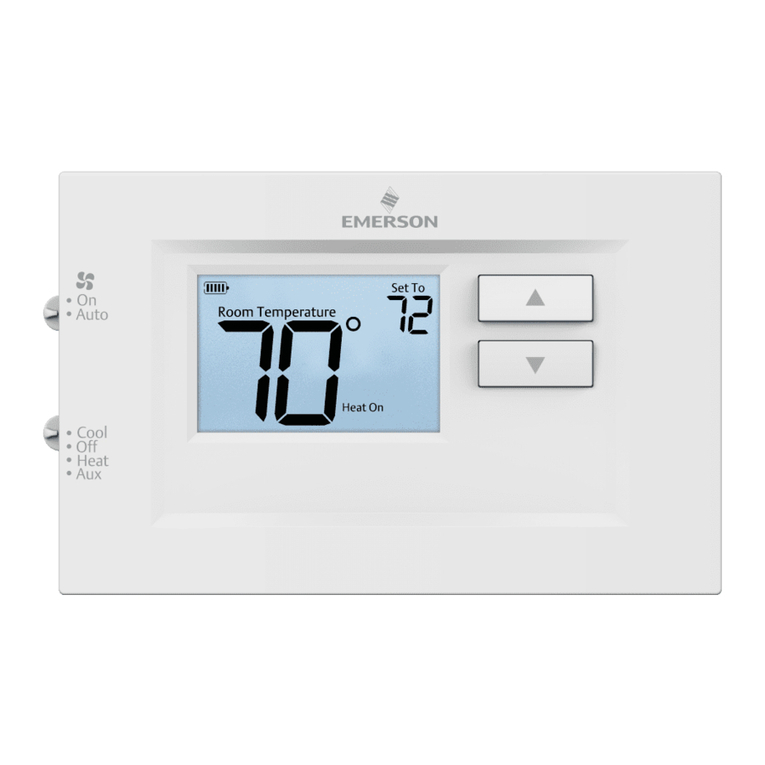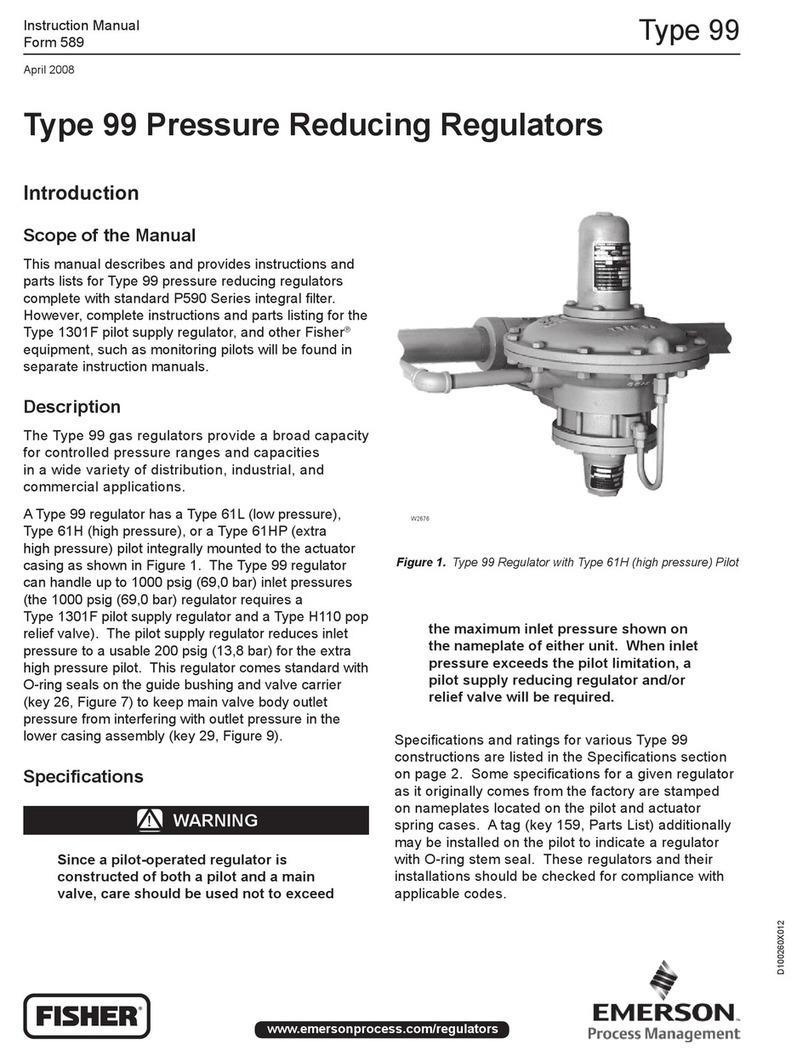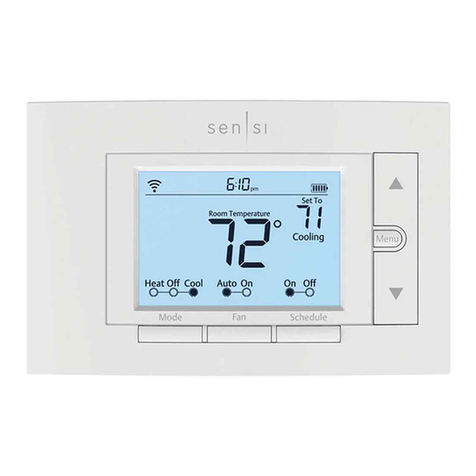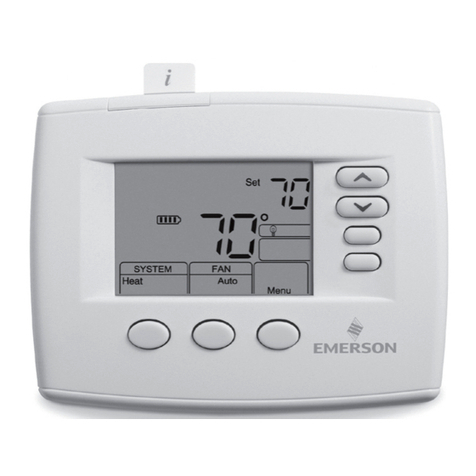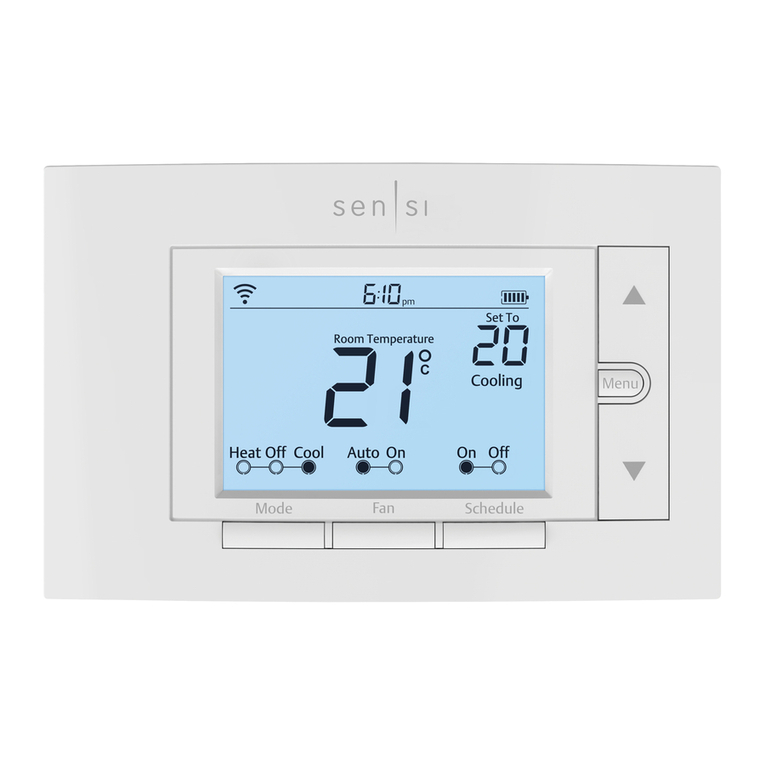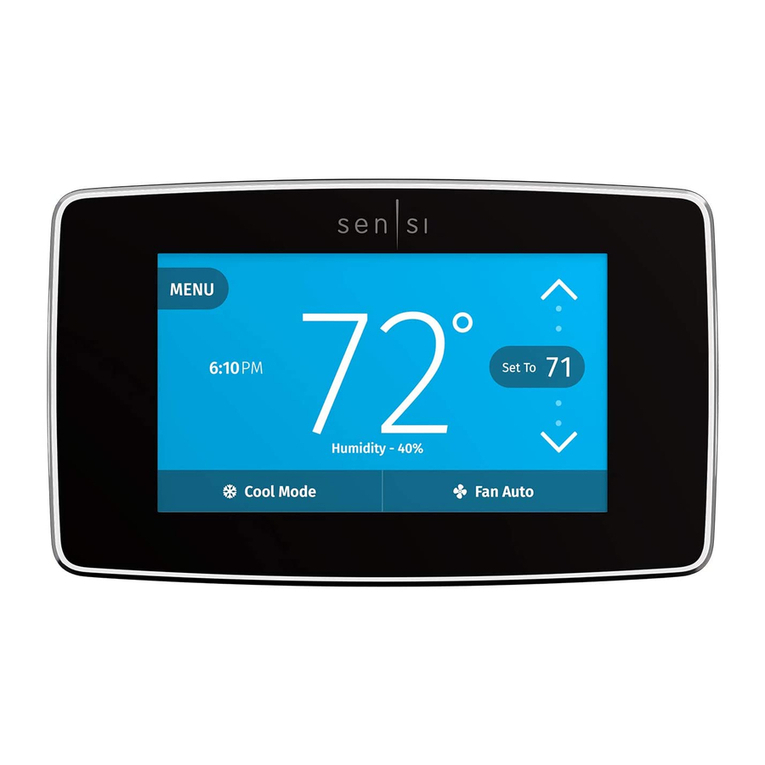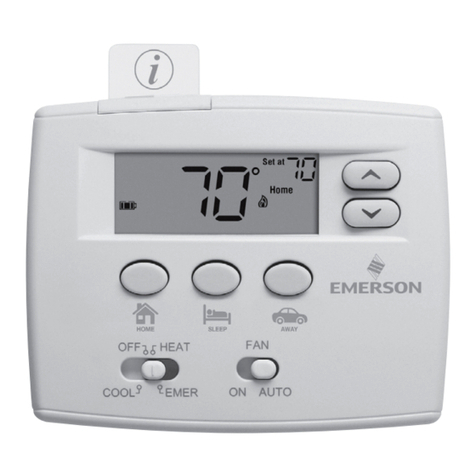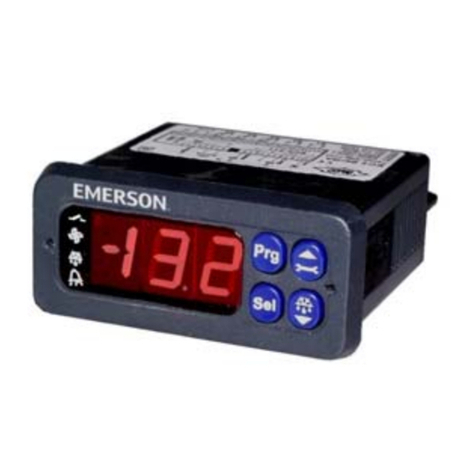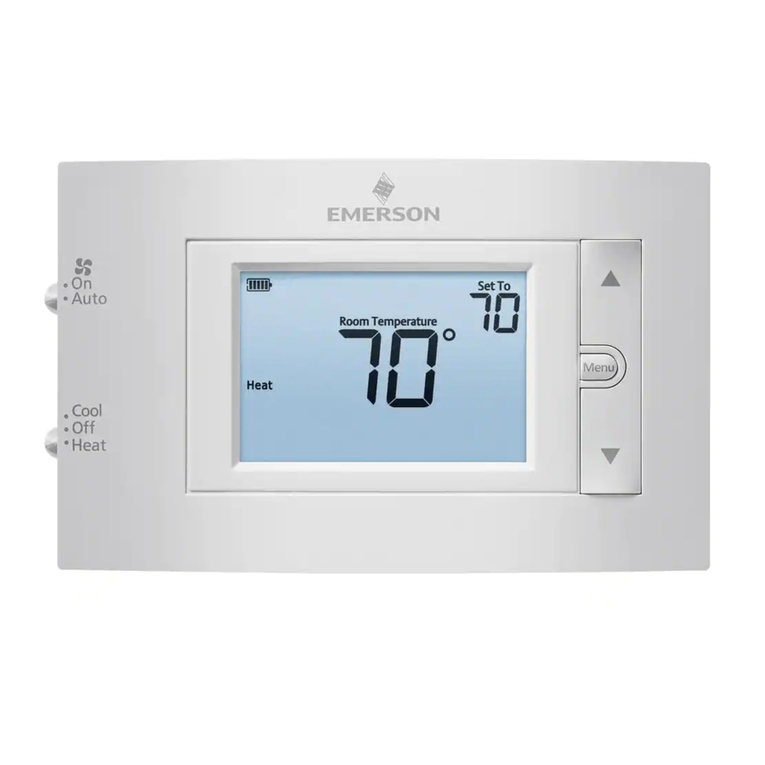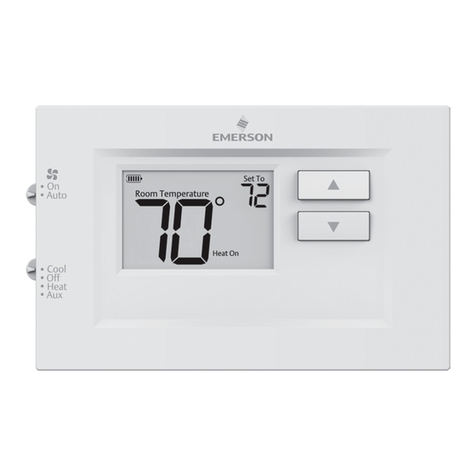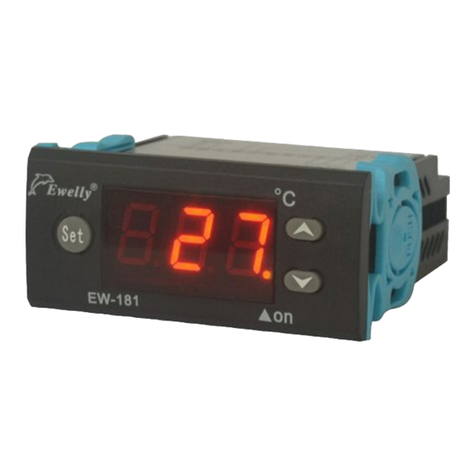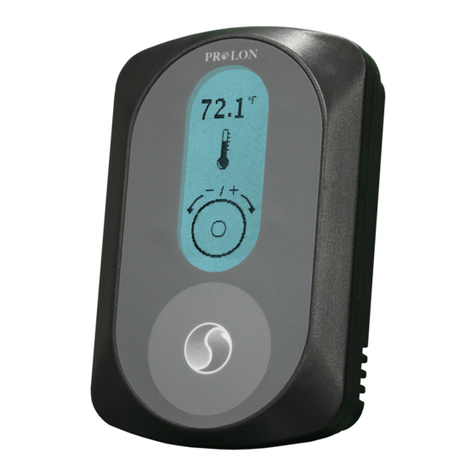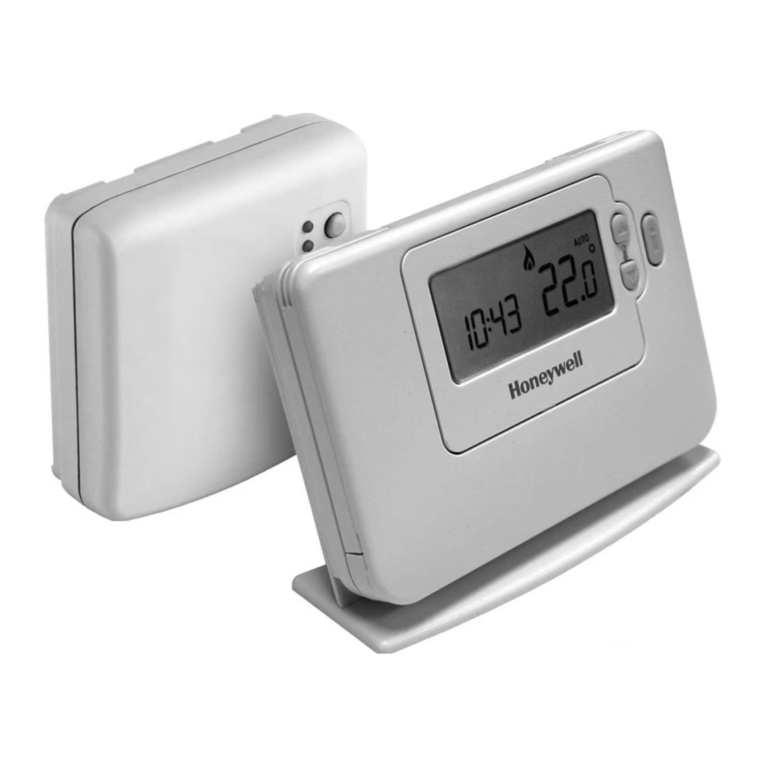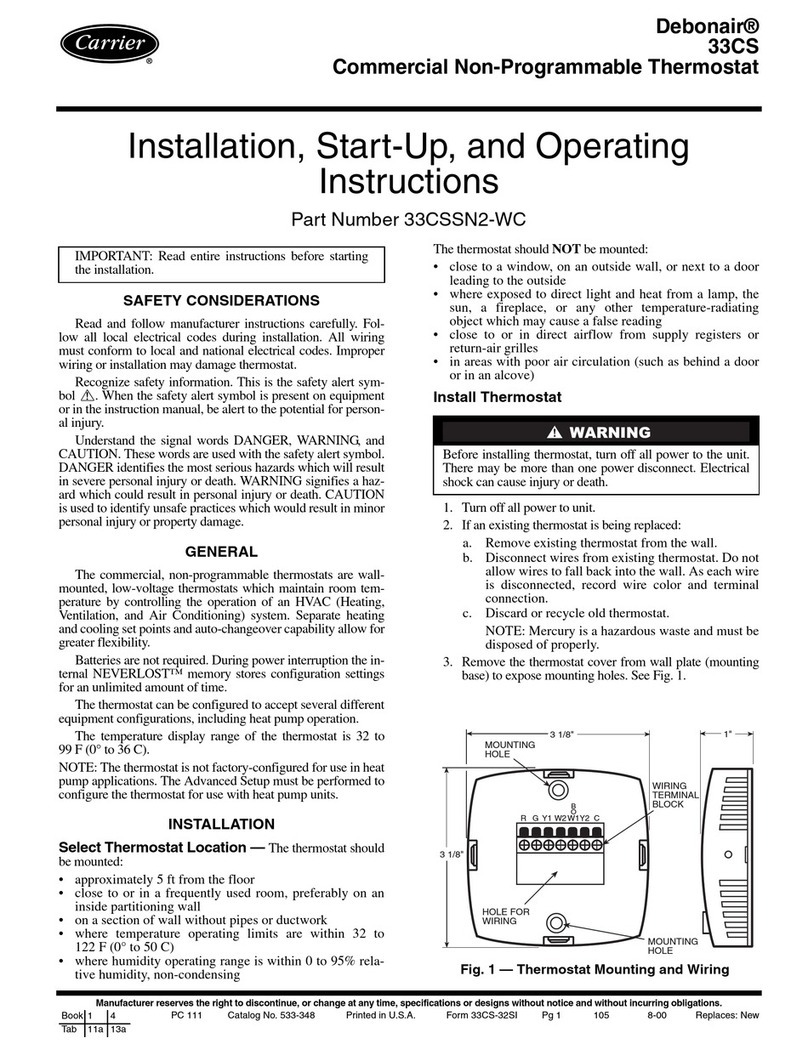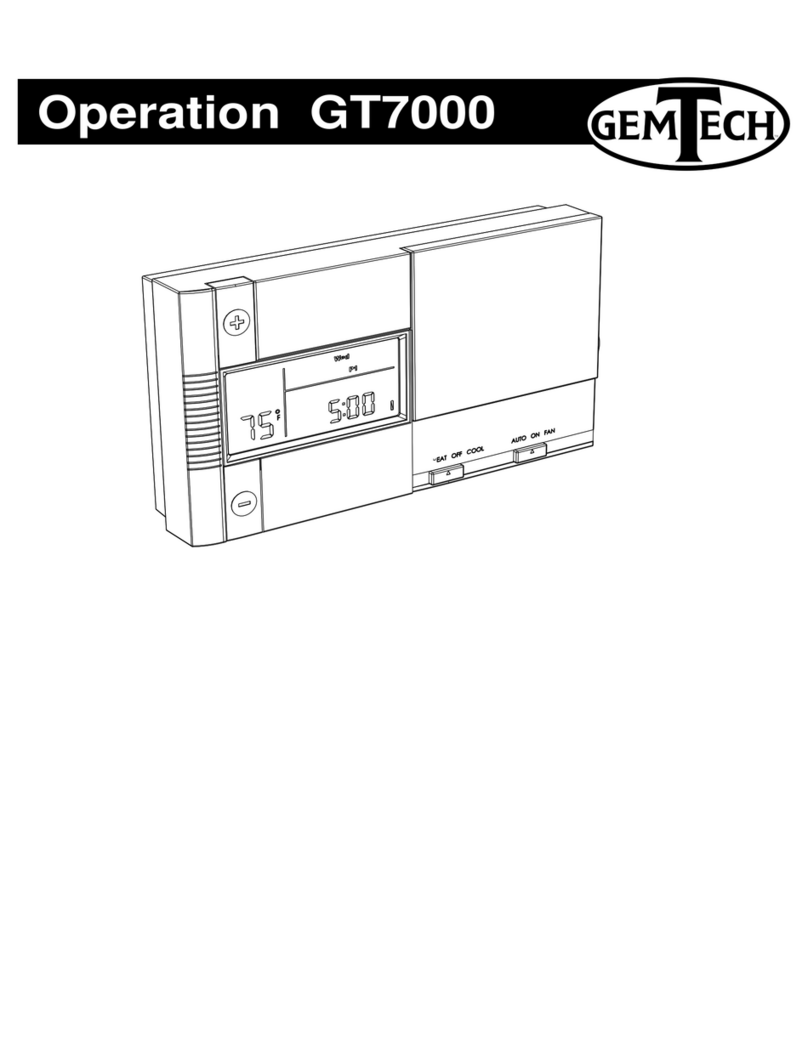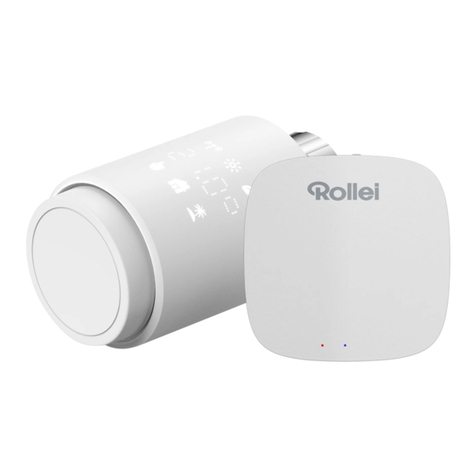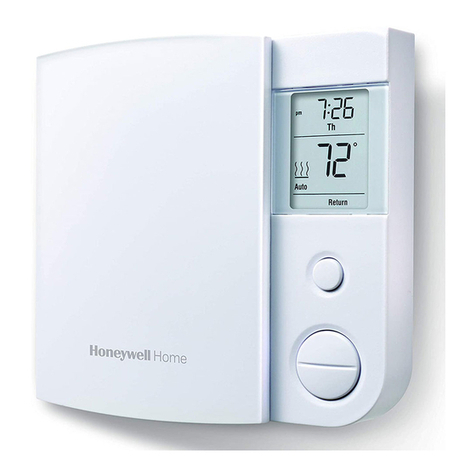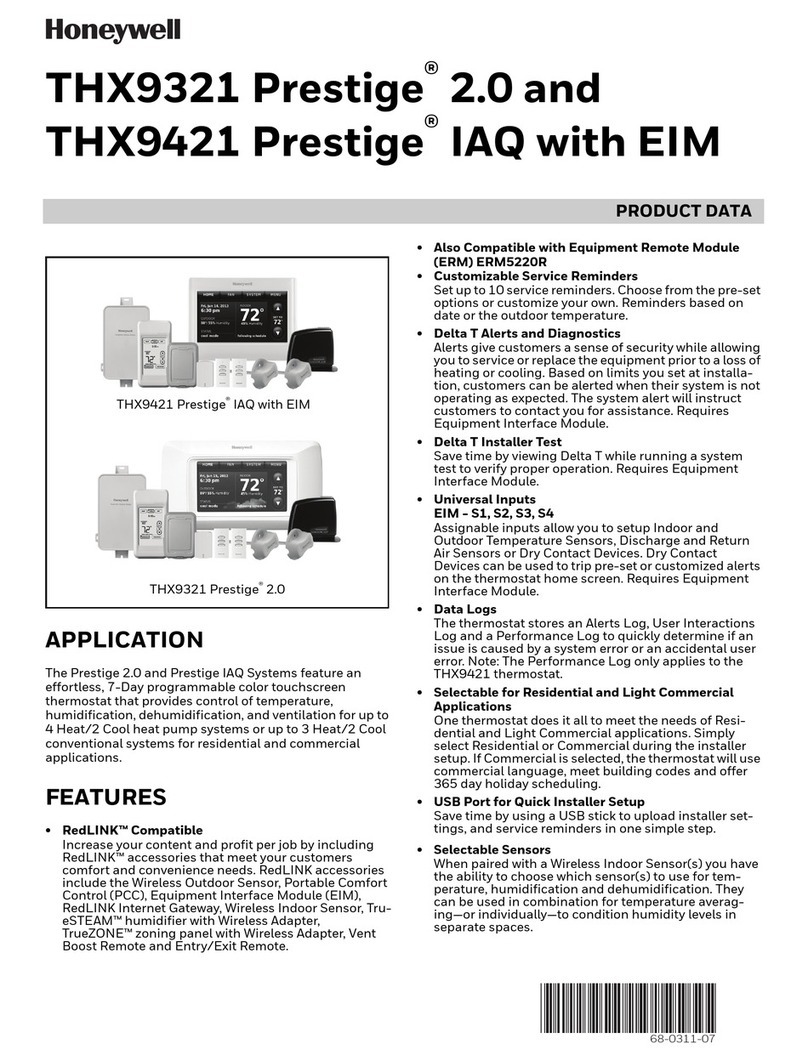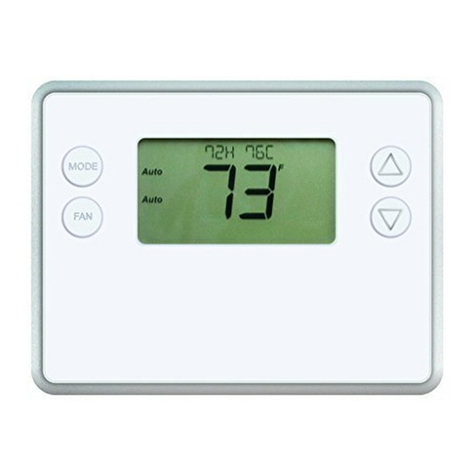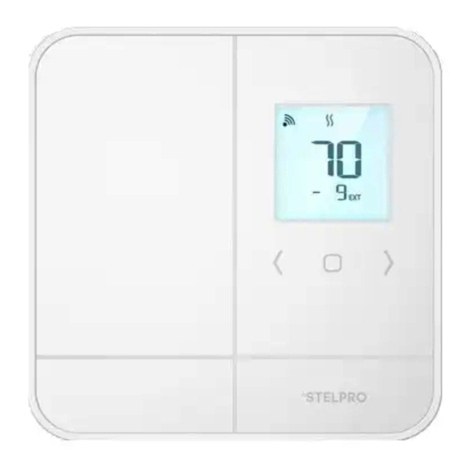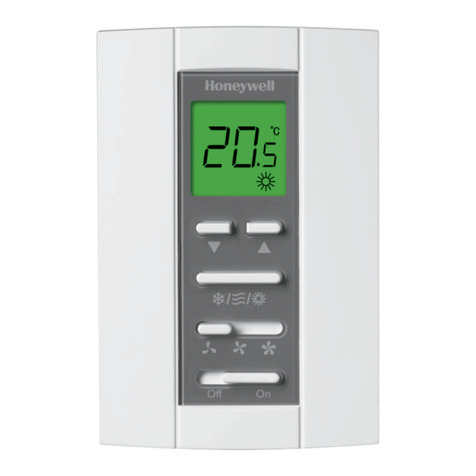
Before removing wires from old thermostat’s switching subbase, label each wirelabel each wire
label each wirelabel each wire
label each wire with the
terminal designation it was removed from.
1.1.
1.1.
1. Remove Old Thermostat:Remove Old Thermostat:
Remove Old Thermostat:Remove Old Thermostat:
Remove Old Thermostat: A standard heat/cool thermostat consists of three basic
parts:
a. The cover, which may be either a snap-on or hinge type.
b. The base, which is removed by loosening all captive screws.
c. The switching subbase, which is removed by unscrewing the
mounting screws that hold it on the wall or adaptor plate.
Make a note here of the anticipator setting on the old thermostat for
future reference and use in step 5.
The heat anticipator pointer, if adjustable, will be set at one of a series of numbers
representing the current rating of the primary control in your furnace. The number will be
one of the following: .2, .4, .8, etc. or 0.2, 0.4, 0.8, etc.
PART NO. 37-6497APART NO. 37-6497A
PART NO. 37-6497APART NO. 37-6497A
PART NO. 37-6497A
0342
Installation Instructions for:Installation Instructions for:
Installation Instructions for:Installation Instructions for:
Installation Instructions for:
Horizontal 1D56-310, -347
Snap-Action 1D56W-347
Vertical 1E56-301, -444
Sealed Mercury Cell 1E56W-444
Horizontal 1F56-301
Sealed Mercury Cell 1F56-306, -444
1F56W-444
YOUR THERMOSTAT REPLACESYOUR THERMOSTAT REPLACES
YOUR THERMOSTAT REPLACESYOUR THERMOSTAT REPLACES
YOUR THERMOSTAT REPLACES
SystemSystem
SystemSystem
System ModelsModels
ModelsModels
Models
Standard Heating & Cooling Systems –
4 or 5 wires
Standard Heat Only Systems
Standard Central Air Conditioning All Models
Gas or Oil Heat
Hydronic (Hot Water) Zone Heat – 2 wires
Electric Furnace 1D56-347, 1D56W-347,
Heat Pump (No Aux or Emergency Heat) 1E56-444, 1E56W-444,
1F56-306, -444, 1F56W-444
Heat Pump (with Aux or Emergency Heat)
Baseboard Electric Heating or Line Voltage
(120 or 240 Volt) None
Millivolt Heat Only Systems –
Floor or Wall Furnaces
Hydronic (Hot Water) Zone Heat – 3 wires
PREPARATIONSPREPARATIONS
PREPARATIONSPREPARATIONS
PREPARATIONS
Assemble tools required: power drill, flat blade screwdriver, wire cutter/stripper, level.
1
Failure to follow and read all instructions carefully before installing or operat-Failure to follow and read all instructions carefully before installing or operat-
Failure to follow and read all instructions carefully before installing or operat-Failure to follow and read all instructions carefully before installing or operat-
Failure to follow and read all instructions carefully before installing or operat-
ing this control could cause personal injury and/or property damage.ing this control could cause personal injury and/or property damage.
ing this control could cause personal injury and/or property damage.ing this control could cause personal injury and/or property damage.
ing this control could cause personal injury and/or property damage.
REMOVING OLD THERMOSTATREMOVING OLD THERMOSTAT
REMOVING OLD THERMOSTATREMOVING OLD THERMOSTAT
REMOVING OLD THERMOSTAT
3
THERMOSTATFEATURESTHERMOSTATFEATURES
THERMOSTATFEATURESTHERMOSTATFEATURES
THERMOSTATFEATURES
2
GRC
Y
W
B
OFF
FAN
AUTO ON SYSTEM
COOL HEAT
Mounting Screw KEEP THIS AREA
CLEAR OF WIRES Hole
in Wall Mounting Screw
Figure 1. Thermostat subbase
ARH
O
▲▲
▲▲
▲CAUTIONCAUTION
CAUTIONCAUTION
CAUTION
!!
!!
!
To prevent electrical shock and/or equipment damage, disconnect electricalTo prevent electrical shock and/or equipment damage, disconnect electrical
To prevent electrical shock and/or equipment damage, disconnect electricalTo prevent electrical shock and/or equipment damage, disconnect electrical
To prevent electrical shock and/or equipment damage, disconnect electrical
power to the system at the main fuse or circuit breaker until installation ispower to the system at the main fuse or circuit breaker until installation is
power to the system at the main fuse or circuit breaker until installation ispower to the system at the main fuse or circuit breaker until installation is
power to the system at the main fuse or circuit breaker until installation is
complete.complete.
complete.complete.
complete.
Ifnoheatanticipator/indication isshowing, donot beconcerned; moveon tothe nextstep.
ATTENTION!ATTENTION!
ATTENTION!ATTENTION!
ATTENTION! This product may or may not contain mercury. Also, this product may
replace a unit which contains mercury.
Do not open mercury cells. If a cell becomes damaged, do not touch any spilled mercury.
Wearing non-absorbent gloves, take up the spilled mercury and place into a container
which can be sealed. If a cell becomes damaged, the unit should be discarded.
Mercurymust notbe discarded in household trash. When theunit thisproduct isreplacing
is to be discarded, place in a suitable container and return to White-Rodgers at 2895
Harrison St., Batesville, AR 72501 for proper disposal.
A.A.
A.A.
A. Remove base from subbaseRemove base from subbase
Remove base from subbaseRemove base from subbase
Remove base from subbase: Loosen the screws on the base and
remove.
B.B.
B.B.
B. Mount switching subbaseMount switching subbase
Mount switching subbaseMount switching subbase
Mount switching subbase: Use the screws provided to mount the
subbase and adaptor plate (optional) to wall (see Fig. 1).
C.C.
C.C.
C. Attach wires to appropriate terminalsAttach wires to appropriate terminals
Attach wires to appropriate terminalsAttach wires to appropriate terminals
Attach wires to appropriate terminals:
• For two wire systems (Heat Only or Cool Only)• For two wire systems (Heat Only or Cool Only)
• For two wire systems (Heat Only or Cool Only)• For two wire systems (Heat Only or Cool Only)
• For two wire systems (Heat Only or Cool Only). If you have a two-wire Heat OnlyHeat Only
Heat OnlyHeat Only
Heat Only
system, attach one wire to RHRH
RHRH
RH and one to wire WW
WW
W. If you have a two-wire Cool OnlyCool Only
Cool OnlyCool Only
Cool Only
system, attach onewire to RCRC
RCRC
RC and oneto wireto YY
YY
Y.Leave thefactory installedjumper
between RCRC
RCRC
RC and RHRH
RHRH
RH attached. Tighten any unused terminals securely.
• If your system has more than two wires• If your system has more than two wires
• If your system has more than two wires• If your system has more than two wires
• If your system has more than two wires: Use the cross reference chart to
determine correct wire connections. If you have a four-wire heat/cool system leave
thefactory installed jumper between RCRC
RCRC
RC and RHRH
RHRH
RH attached (seeFig2.). Ifyour system
has five wires remove the factory installed jumper between RCRC
RCRC
RC and RHRH
RHRH
RH (see Fig 3.).
• Electric heat or single stage heat pump systems• Electric heat or single stage heat pump systems
• Electric heat or single stage heat pump systems• Electric heat or single stage heat pump systems
• Electric heat or single stage heat pump systems: 1F56-306 energizes the fan
on call for heat. Other thermostats are configured from the factory to operate a heat/
cool, fossil fuel (gas, oil, etc.) forced air system. This is correct for any system that
DOESNOT requirethe thermostatto energizethe fan on a call for heat.If yoursystem
isan electric heat or heat-pump system thatREQUIRES thethermostat toturn onthe
fan on a call for heat, remove the yellow factory-installed jumper wire from the YY
YY
Y
terminal and connect it to the AA
AA
A terminal. This will allow the thermostat to energize
the fan immediately on a call for heat. If you are unsure if the heating system requires
the thermostat to control the fan, contact a qualified heating and air conditioning
service person. For single stage heat pump applications (no auxillary heat), install a
short jumper wire (not included) across terminals WW
WW
W and YY
YY
Y. If the system has a
reversing valve connection energized in Cooling, attach it to OO
OO
O. If the system has a
reversing valve connection energized in Heating, attach it to BB
BB
B (see Fig. 4). This
thermostat will not provide multi-stage heating or cooling.
D.D.
D.D.
D. Mount Thermostat BaseMount Thermostat Base
Mount Thermostat BaseMount Thermostat Base
Mount Thermostat Base: Gently push excess wire back into the wall
opening and plug hole with a fire-resistant material, such as fiberglass
insulation to prevent drafts from affecting thermostat operation. Mount
the thermostat base to the subbase using the three captive screws on the
thermostat base. (See Fig. 1) Tighten the screws securely. Remove
paper tag from plastic contact cover. Proceed to Step #5.
MOUNTING AND WIRINGMOUNTING AND WIRING
MOUNTING AND WIRINGMOUNTING AND WIRING
MOUNTING AND WIRING
4
▲▲
▲▲
▲WARNINGWARNING
WARNINGWARNING
WARNING
!!
!!
!
Do not use on circuits exceeding specified voltage. Higher voltage will dam-Do not use on circuits exceeding specified voltage. Higher voltage will dam-
Do not use on circuits exceeding specified voltage. Higher voltage will dam-Do not use on circuits exceeding specified voltage. Higher voltage will dam-
Do not use on circuits exceeding specified voltage. Higher voltage will dam-
age control and could cause shock or fire hazard.age control and could cause shock or fire hazard.
age control and could cause shock or fire hazard.age control and could cause shock or fire hazard.
age control and could cause shock or fire hazard.
Do not short out terminals on gas valve or primary control to test. Short orDo not short out terminals on gas valve or primary control to test. Short or
Do not short out terminals on gas valve or primary control to test. Short orDo not short out terminals on gas valve or primary control to test. Short or
Do not short out terminals on gas valve or primary control to test. Short or
incorrect wiring will damage thermostat and could cause personal injury and/incorrect wiring will damage thermostat and could cause personal injury and/
incorrect wiring will damage thermostat and could cause personal injury and/incorrect wiring will damage thermostat and could cause personal injury and/
incorrect wiring will damage thermostat and could cause personal injury and/
or property damage.or property damage.
or property damage.or property damage.
or property damage.
Thermostat installation and all components of the system shall conform toThermostat installation and all components of the system shall conform to
Thermostat installation and all components of the system shall conform toThermostat installation and all components of the system shall conform to
Thermostat installation and all components of the system shall conform to
Class II circuits per the NEC code.Class II circuits per the NEC code.
Class II circuits per the NEC code.Class II circuits per the NEC code.
Class II circuits per the NEC code.
TERMINAL CROSS REFERENCE CHARTTERMINAL CROSS REFERENCE CHART
TERMINAL CROSS REFERENCE CHARTTERMINAL CROSS REFERENCE CHART
TERMINAL CROSS REFERENCE CHART
New ThermostatNew Thermostat
New ThermostatNew Thermostat
New Thermostat Other Manufacturers’Other Manufacturers’
Other Manufacturers’Other Manufacturers’
Other Manufacturers’
Terminal DesignationTerminal Designation
Terminal DesignationTerminal Designation
Terminal Designation Terminal DesignationTerminal Designation
Terminal DesignationTerminal Designation
Terminal Designation
**
RH 4 RH M R5 R
RC R R V – –
GGGFGG
WWWH4W
YYYCY6Y
* These are four-wire, single-transformer systems. Factory installed jumper wire
between the RH and RC terminals must remain in place.
▲▲
▲▲
▲CAUTIONCAUTION
CAUTIONCAUTION
CAUTION
!!
!!
!
Take care when securing and routing wires so they do not short to adjacentTake care when securing and routing wires so they do not short to adjacent
Take care when securing and routing wires so they do not short to adjacentTake care when securing and routing wires so they do not short to adjacent
Take care when securing and routing wires so they do not short to adjacent
terminals or rear of thermostat. Personal injury and/or property damage mayterminals or rear of thermostat. Personal injury and/or property damage may
terminals or rear of thermostat. Personal injury and/or property damage mayterminals or rear of thermostat. Personal injury and/or property damage may
terminals or rear of thermostat. Personal injury and/or property damage may
occur.occur.
occur.occur.
occur.
REMOVING OLD THERMOSTAT (cont’d)REMOVING OLD THERMOSTAT (cont’d)
REMOVING OLD THERMOSTAT (cont’d)REMOVING OLD THERMOSTAT (cont’d)
REMOVING OLD THERMOSTAT (cont’d)
3
White-Rodgers is a division
of Emerson Electric Co.
www.white-rodgers.com
O, B, A terminals not
available on 1D56-310,
1E56-301, 1F56-301, -306
